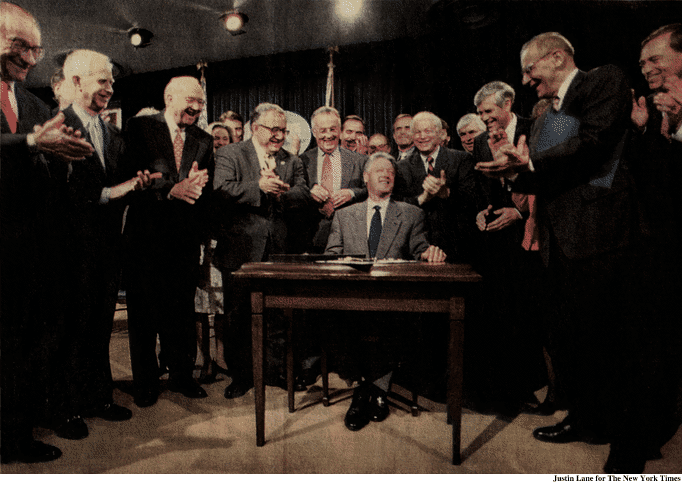"The Troubled Asset Relief Program [TARP] is a program of the United States government to purchase assets and equity from financial institutions to strengthen its financial sector. It is the largest component of the government’s measures in 2008 to address the subprime mortgage crisis."
Did TARP Increase Lending?
New York Times
By Casey B. Mulligan, an economics professor at the University of Chicago.
October 7, 2009
Economic theory casts significant doubt on the claim that public purchases of bank equity would cause banks to lend more. Now the government’s own watchdog confirms the theory. During last year’s financial crisis, regulators and market participants grew alarmed at the low levels of bank capital. This motivated the bank bailout, and promises to the public that the bailouts would get the banks — especially nine “healthy banks” targeted by Treasury officials — lending again.
Bank capital refers to the excess value of banks’ assets over their liabilities. Bank capital belongs to the bank shareholders, but provides a degree of insurance to the bank’s creditors — its depositors and bond holders — because their claims on bank assets are senior to those of bank shareholders. Some claim that adequate bank capital is also essential for lending.
The Federal Reserve and the Bush administration let some banks fail last year, but ultimately desired to do something to replenish bank capital. They convinced Congress that they could do so, and had $700 billion [almost $7,000 for every United States household] earmarked for that purpose. Almost $300 billion of that amount had been awarded to banks between late October 2008 and Inauguration Day, in the form of Treasury purchases of newly issued bank stock.
Officials never admitted to the taxpayers [whose money they requested] that the marketplace might largely, if not entirely, thwart their recapitalization efforts. The market might well react to Treasury share purchases by reducing private holdings of bank capital. Nor did officials admit that, even if the bailout helped replenish bank capital, banks might not want to use their newfound capital for lending. This was also a relevant consideration, because it is possible that lending opportunities determine bank capital, rather than the reverse.
Part of the bank bailout law established an Office of the Special Inspector General for the Troubled Asset Relief Program [a k a “SIGTARP”] “to conduct, supervise and coordinate audits and investigations of the purchase, management and sale of assets under the TARP.” The inspector general was appointed by President George W. Bush and approved by the Senate. With the better part of a year to examine the evidence, SIGTARP released an audit report on Monday. It concluded [p. 30] that “…lending at [the nine targeted banks] did not in fact increase….”
The report goes on to lament that this episode could “damage the trust that the American people have in their government.” I would put it stronger: This episode is an expensive example of public policy promises that were doomed to failure because they were known at the outset to defy economic theory.
In the spring of 1987, the Federal Reserve Board votes 3-2 in favor of easing regulations under Glass-Steagall Act, overriding the opposition of Chairman Paul Volcker. The vote comes after the Fed Board hears proposals from Citicorp, J.P. Morgan and Bankers Trust advocating the loosening of Glass-Steagall restrictions to allow banks to handle several underwriting businesses, including commercial paper, municipal revenue bonds, and mortgage-backed securities. Thomas Theobald, then vice chairman of Citicorp, argues that three "outside checks" on corporate misbehavior had emerged since 1933: "a very effective" SEC; knowledgeable investors, and "very sophisticated" rating agencies. Volcker is unconvinced, and expresses his fear that lenders will recklessly lower loan standards in pursuit of lucrative securities offerings and market bad loans to the public. For many critics, it boiled down to the issue of two different cultures – a culture of risk which was the securities business, and a culture of protection of deposits which was the culture of banking.
The aging Mr. Volcker has some advice, deeply felt. He has been offering it in speeches and Congressional testimony, and repeating it to those around the president, most of them young enough to be his children. He wants the nation’s banks to be prohibited from owning and trading risky securities, the very practice that got the biggest ones into deep trouble in 2008. And the administration is saying no, it will not separate commercial banking from investment operations. “I am not pounding the desk all the time, but I am making my point,” Mr. Volcker said in one of his infrequent on-the-record interviews. “I have talked to some senators who asked me to talk to them, and if people want to talk to me, I talk to them. But I am not going around knocking on doors.”


GLASS-STEAGALL

GRAMM-LEACH-BLILEY
or Why are they smiling?
You are so right on target. Why don’t they get it in DC? Would they get it if they weren’t blinded by lobbyists’ money or by their own investment ties to the financial industry?